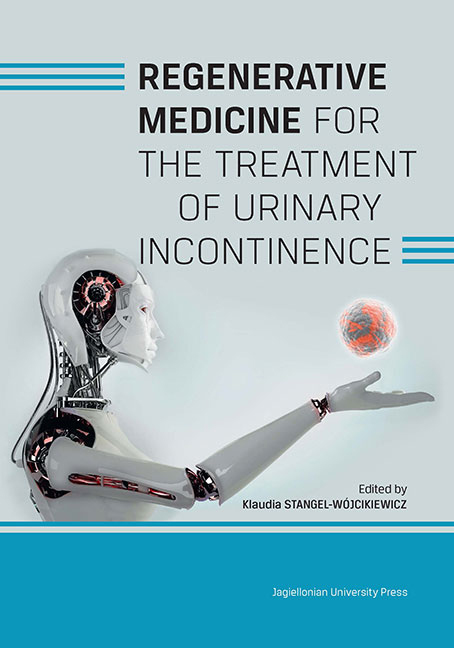Book contents
- Frontmatter
- Contents
- Preface
- Introduction
- Chapter 1 Urinary incontinence in women - outline of the problem
- Chapter 2 Anatomy of the urogenital system
- Chapter 3 Clinical types of urinary incontinence
- Chapter 4 Treatment of stress urinary incontinence
- Chapter 5 Regenerative medicine for the treatment of urinary incontinence
- Chapter 6 Virtual Patient system - simulations of clinical encounters for medical education. Case study of a woman with urinary incontinence
- Chapter 7 Development of a robotic tool aiding a new stem cell-based treatment for stress urinary incontinence in women
- Chapter 8 Difficulties and limitations of cell-based therapy for the treatment of urinary incontinence
- Summary
- List of authors
Chapter 5 - Regenerative medicine for the treatment of urinary incontinence
Published online by Cambridge University Press: 03 January 2018
- Frontmatter
- Contents
- Preface
- Introduction
- Chapter 1 Urinary incontinence in women - outline of the problem
- Chapter 2 Anatomy of the urogenital system
- Chapter 3 Clinical types of urinary incontinence
- Chapter 4 Treatment of stress urinary incontinence
- Chapter 5 Regenerative medicine for the treatment of urinary incontinence
- Chapter 6 Virtual Patient system - simulations of clinical encounters for medical education. Case study of a woman with urinary incontinence
- Chapter 7 Development of a robotic tool aiding a new stem cell-based treatment for stress urinary incontinence in women
- Chapter 8 Difficulties and limitations of cell-based therapy for the treatment of urinary incontinence
- Summary
- List of authors
Summary
Harvesting and isolation of autologous myoblasts
For many years it was thought that muscle tissue does not contain stem cells that would enable its regeneration and growth in mature stages. In 1961 muscle progenitor cells were discovered in frog skeletal muscles by investigating the morphology and location of muscle fibres [1]. In 1976 Schultz et al. identified these cells in humans [2]. Skeletal muscle progentitor cells, also known as myosatellite cells, are small mononuclear cells located between the basement membrane and the sarcolemma of muscle fibres [1, 3]. Much information about these cells was derived from experiments on animals with mutations producing symptoms similar to those in humans with muscular dystrophy, and on knock-out mice without genes determining the development and maturation of muscle cells [1, 4, 5]. Myosatellite cells are involved in muscle regeneration after intense physical exercise or injuries to muscle tissue [1, 3, 6].
There are several methods for the isolation of myosatellite cells. The most common one is multiple passage, to eliminate fibroblasts and obtain cell culture containing satellite cells. Another isolation method employs markers found on the surface of satellite cells. To date, several such cell-surface markers have been identified. Myosatellite cells express, for example, c-met proto-oncogene (MET protein), which is the receptor for hepatocyte growth factor (HGF), identified in quiescent satellite cells, and M-cadherin [1, 3]. Satellite cells also express the functional CXC chemokine receptor 4 (CXCR4) on their surface, and a specific ligand for this receptor, alpha-chemokine stromal-derived factor 1 (SDF-1) [7]. This receptor is also found on the surface of stem cells and is responsible for their migration [8]. Markers expressed on the surface of satellite cells can be used for the isolation of muscle cell populations containing satellite cells and for their in vitro culture on special media.
Experimental and clinical studies
The development of methods for in vitro culture and proliferation of muscle cells allowed for testing the suitability of cell-based therapy employing autologous myoblast cells for the treatment of UI and other medical conditions.
- Type
- Chapter
- Information
- Publisher: Jagiellonian University PressPrint publication year: 2016



